Here, in the center of our camp, the sacred fire burns. This fire is tended for the four days we are together, never being allowed to go out. This is an ancestral fire, and all of us at the Mountaincraft gathering have the responsibility of feeding it. This is where we remember that learning primitive and earth skills is the work of our ancestors. This is where we gather for a quiet moment to commune with those ancestors, and will our bodies and hearts to remember. This is where, each morning, we gather as a group to hear about the day’s classes, call to the directions, hear a word of intention, and receive a water blessing from Nancy Basket, a tribe elder. This is where, at each meal, some of us may find ourselves, talking with each other or engaging in quiet communion with the flame. This is where, each night, we gather to drum, dance, and connect with all in this community. This is where many classes are taught, using fire as a tool for cooking, dye, carving, and more. The ancestor fire at the heart of the Mountaincraft gathering is the heart of the gathering itself–and it represents much of what we’ve come here to do.
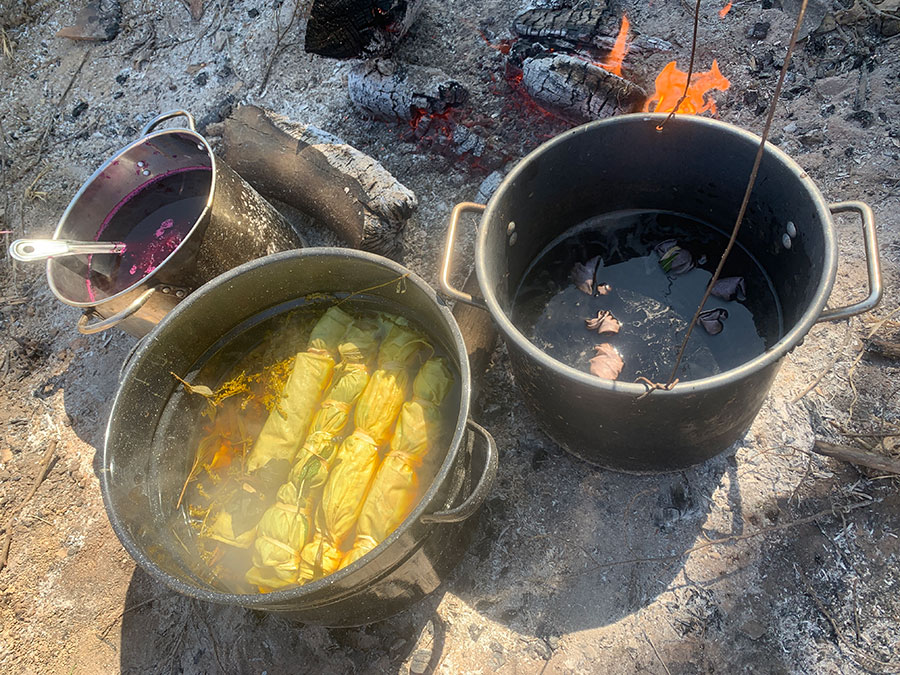
As I’ve already begun to do, in this post, I’m reviewing my recent experience at the Mountaincraft gathering. I’ll offer a full review, and also share at the end of the review how you might find a similar earth / primitive skills gathering, and why, if you are interested in nature spirituality and druidry, you might really want to do so! And so, let’s get back to honoring the ancestors.
While I had been at the North American School of Bushcraft a few times before, this was my first time at their annual Mountaincraft and Music Gathering–and in fact, my first earth skills gathering ever. This gathering focuses on the wide variety of earth skills and primitive skills that our ancestors once knew, and that many of us are now trying to re-learn and preserve. Held yearly in early September in Hedgesville, WV at the North American Bushcraft School, this gathering is a wonderful time for people to gather together to learn, teach, share, and grow. I have been looking forward to this gathering for quite some time, and I invited two druid friends to go with me. And what a time we had.
A typical day at Mountaincraft looks like this: breakfast starts at 7am and ends at 8:30. At 9:30, we have morning circle around the fire. Morning circle is as I described above: part announcements, part community building, and part ceremony. We hear about the day’s classes from each of the many instructors–they introduce themselves, what they will be teaching and where. We get a word of intention for the day, which helps us focus our energy in a useful direction. We gain a water blessing (and sometimes a song) from Nancy Basket, who uses cedar to flick each of us with pure water. Then, we go off to one of many classes offered. Usually about 7-10 classes are being held at any one time. The morning class runs from 10am till 12:30. Lunch is till 1:30 and classes begin again at 2 and run till 5:30. The gathering provides breakfast and lunch, so then everyone goes off to cook or pays for a delicious purchased meal. Signups for classes start at dinner the day before, so around dinner, so everyone visits the board and sees what the next day’s offerings are and sign up. Many find it difficult to choose as so many good options are available. As it gets dark, everyone gathers for drumming and connection. There might be trading activities (trade blanket, or trading/sales of items) or some other activity. The final evening of the gathering, Saturday evening, they had two fantastic Bluegrass bands (I’m not even a fan of Bluegrass but these were quite fun and enjoyable!) Then you go to your tent and enjoy your rest. While it sounds like you stay quite busy, the schedule is quite relaxed and things happen at their own pace. Earth skills are not “fast” skills, rather, they work on slow time. The gathering’s pace reflects this powerful lesson.

Each day at the gathering offered new classes and exciting opportunities to learn. It was often quite hard to pick between the many classes. Here are just some of the many classes that were offered this year: Wilderness survival 101, map and compass, navigation without maps, bow drill firemaking (make your own kit and learn to use it), friction fires of the world, 40 minute forks, spoon carving, blacksmithing 101, make your own atlatl, primitive pottery, zen and the art of woodchopping, tool maintenance, make handles for tools from trees, make a milking stool from a log, flintknapping, tomahawk throwing and course, bow course, cordage, basketry (many, many different types–pine needles, kudzu, vine, etc) combined with storytelling, fingerweaving, natural dyes, bark baskets, parkour, campfire cooking, indigo and shibori dye, leatherwork: moccasins, make your own leather pants or skirt, process a deer and use all parts, cattail reed mat making, herbalism 101, salve making, naturalist classes, nature awareness, weed walks and plant walks, eating bugs and mushrooms, tree identification, drumming, learning guitar and banjo (and other music), nature identification, and so many more I can’t remember and didn’t write down! There was also a full 3.5 day kids program, where kids did many different earth skills along with plenty of play time, swimming, and nature hikes. This allowed the kids autonomy and also allowed parents to go to their own classes knowing that their kids were in good hands. There were also daily sweat lodges that you could sign up for–I did not do a lodge but one of my druid friends did and had an amazing experience.
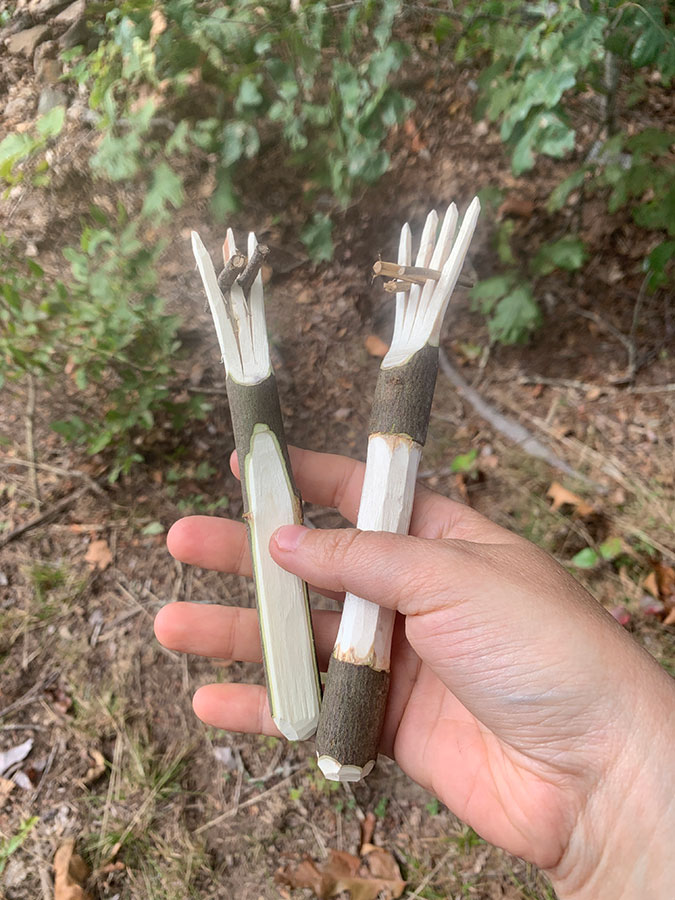
On my first day, I spent the morning learning “40 minute forks” from Fuz, a long-time earth skills instructor from North Carolina. This was a great class to help me build confidence with my knife skills, whittling skills and create some simple forks. Fuz was a strong presence throughout the gathering, not only teaching a wide range of primitive skills (carving, wood chopping, drumming) but he was also very active in the drum circles at night, helping us feel welcome and leading some great beats.
The afternoon class was primitive pottery with Keith. We made our way down to the creek bed, dug clay from the bank, and learned how to hand wedge it. Covered in mud, we came back to the primitive pottery area, where we shaped the clay into bowls and other objects. On Saturday late afternoon, after drying the pottery by the fire, the kiln was built on top of hot ashes and all of our pots went inside. Then, we built a bonfire on top of it and watched it burn I remember standing there with our pots, at about 11pm on Saturday night. Bluegrass band playing in the background, heat of the fire before me, and just thinking what an amazing experience this was–to use fire as such a powerful tool. Evening came and my friends and I shared a meal and some downtime at our campsite. We then went down to the ancestral fire, where we participated in the best drum circle jam I have ever been enjoyed!
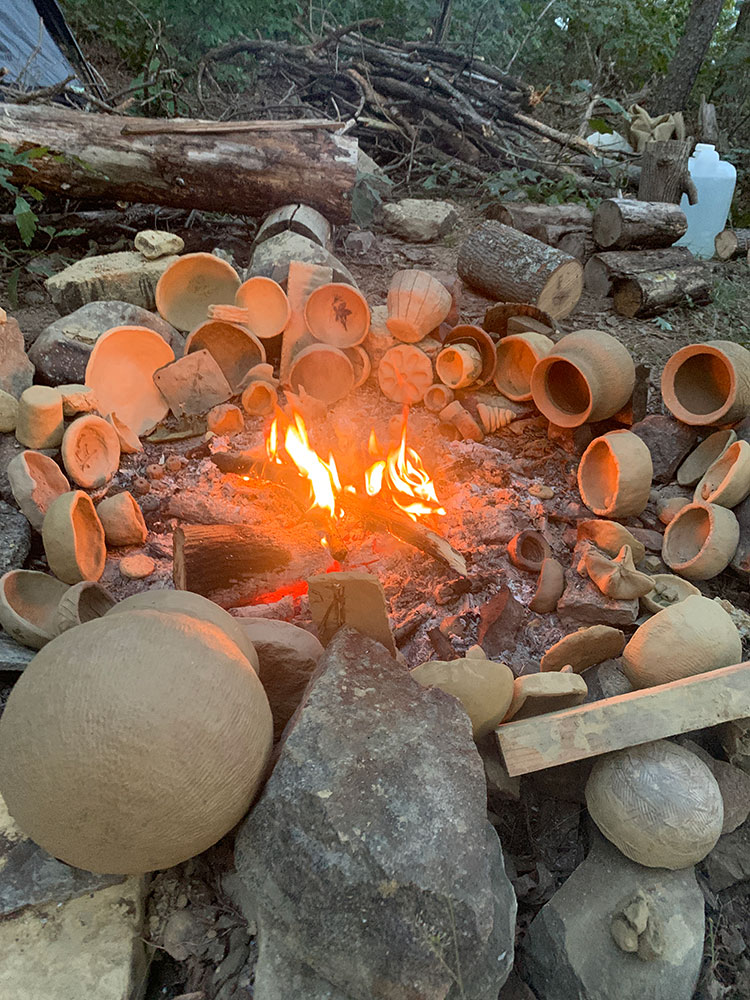
The second day cordage in the morning with Jeff Gottleib. I loved everything about Jeff’s teaching style: practical, knowledgable, friendly, and encouraging. Jeff was a professional earth skills instructors and naturalist and it really showed. He walked us through the intricacies of creating cordage from various plants and trees, and had tons of examples to look at. We made dogbane cordage and then some hemp cordage. He even had a book on the topic for more info, which I was lucky enough to purchase for reference. (He has a site and Youtube channel you can check out here).
After a great lunch, I went to my afternoon class, which was dyeing with indigo and traditional shibori techniques with Stephanie Davis. I have been longing to learn these techniques for years! Stephanie’s workshop was amazing. Stephanie brought out examples, pictures, and had her own indigo-dyed clothing and tapestries everywhere for examples. She offered us a box of clothing and we took what would fit. I ended up with a great cotton sleeveless shirt and an long runner I will use as an altar cloth. Stephanie’s instruction in indigo was magical. Each of us finished our preparation (with various stitches, string, rubber bands, and more) and then made our way to the dye vat. Stephanie worked with each of us, slowly and purposefully, to dye our work and remove it quickly so that we did not add oxygen to the vat. Her gentle guidance added *so much* to the learning process–I felt like she taught us how to commune with the dye, how to work with the Indigo plant behind it. My two pieces came out beautifully. Many of us stayed to watch the last of the items get unwrapped like precious gifts. I left that class with my heart so full.
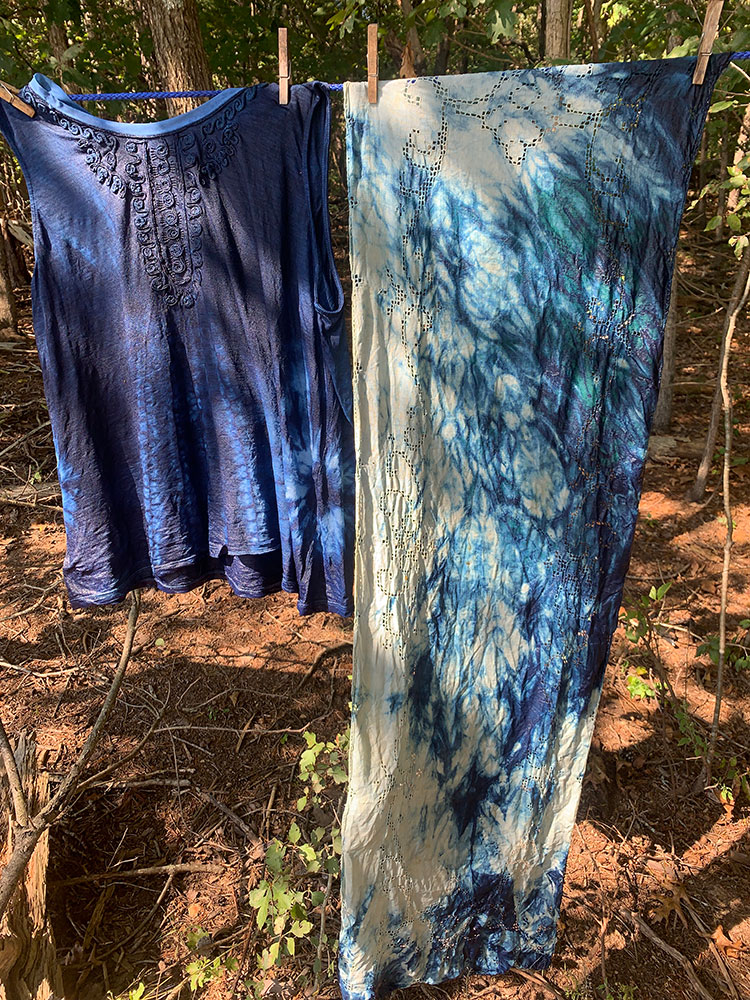
Friday night offered a traditional trade blanket. Each of us who participated brought multiple kinds of trades. We took turns, going around the blanket and offering trades. Or doing side trades, which are ok. I ended up trading for a bag of spicebush seeds (yay for replanting my land), a small leather bag, beads, dried hen of the woods mushrooms, a self-published coloring book, and a wonderful wool shawl with arm holes. I gave iron oxide pigment, guinea and goose feathers, a handmade leather journal, small gourds, and a small gourd drum. This was a very fun time and a good way to get to know people at the event. For an overview of what this is, you can see this page.
Saturday is the “big day” of the gathering. Lots of new folks rolled in and there were at least 10-15 classes running at all times–and again so many choices! I decided to do a natural dye and ecoprinting class in the morning. My natural dye class was great–we foraged for materials, learned about dyes and preparation, and prepared and used three different dyes: a pokeberry dye, a walnut dye, and a goldenrod dye. The best thing about this class is that we did these dyes over our ancestral fire, just like our ancestors would have. We gathered the plants and stained our fingers and faces with pokeberries.
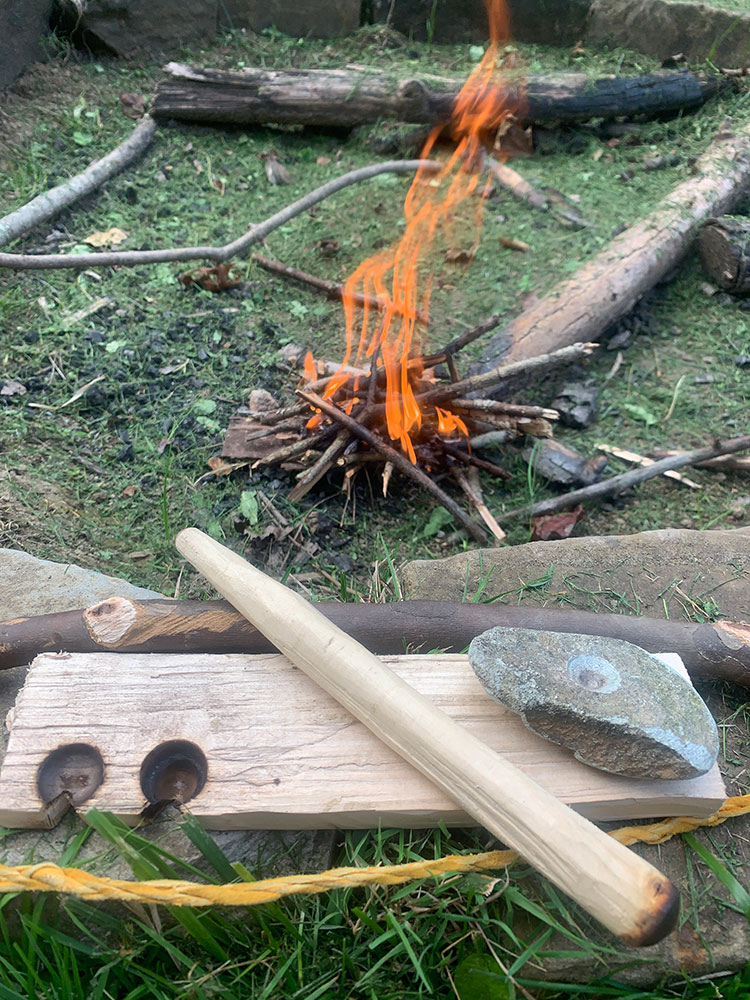
My Saturday afternoon class was my last class of the gathering, since I had to return early on Sunday. But I consider this class my greatest success–it was certainly the most physically demanding and challenging but also rewarding. I had class with Jeff again. This time, he was teaching us how to make bow drill kits for friction fire building. We started with a good chunk of dried basswood he harvested. He showed us how to quarter the log and get boards from them, each student making their own board. He then took the rest and offered us smaller shards to carve down into our round drill. After a good deal of carving, we were ready to make the bow. We harvested our drill wood itself and then added lines or did a 3-ply cordage technique with leather. By this time, we had been making our kits for several hours. Many of the other classes had finished for the day, but we were determined to start fires with our kits! It took me about 15 minutes of practice to get the hang of it, but then, I HAD AN EMBER! And then, a minute or so later, I had made fire. I felt so alive, so proud, so accomplished. From my own hands, I took pieces of split wood and turned them into a friction fire kit that really worked. I spent most of the evening riding my bow drill fire high, thankful to have learned this skill and feeling damn accomplished. Since returning home, I’ve made three embers and one successful fire with my bow drill–and it tremendously deepened my relationship to fire!
That evening was awesome. We had the trader setup, where you could sell or trade for items from a wide variety of folks who had stuff at the gathering. There were soaps, jams and jellies, herbal medicine, knives, feathers and bones, old school lanterns, various tools, and so many more interesting things. As that winded down, the party began, and we enjoyed homebrew and two amazing bluegrass bands. I ended that evening at the primitive fire pit watching my pots turn to molten orange. Sunday at the gathering is a half-day, but unfortunately, I had to leave early due to having to go to work later on Sunday. I said goodbye and drove away with my heart so full and my mind active, the awen strongly flowing through me!
I want to conclude with a few general thoughts and encourage you to go to Mountaincraft or another Earth Skills gathering:
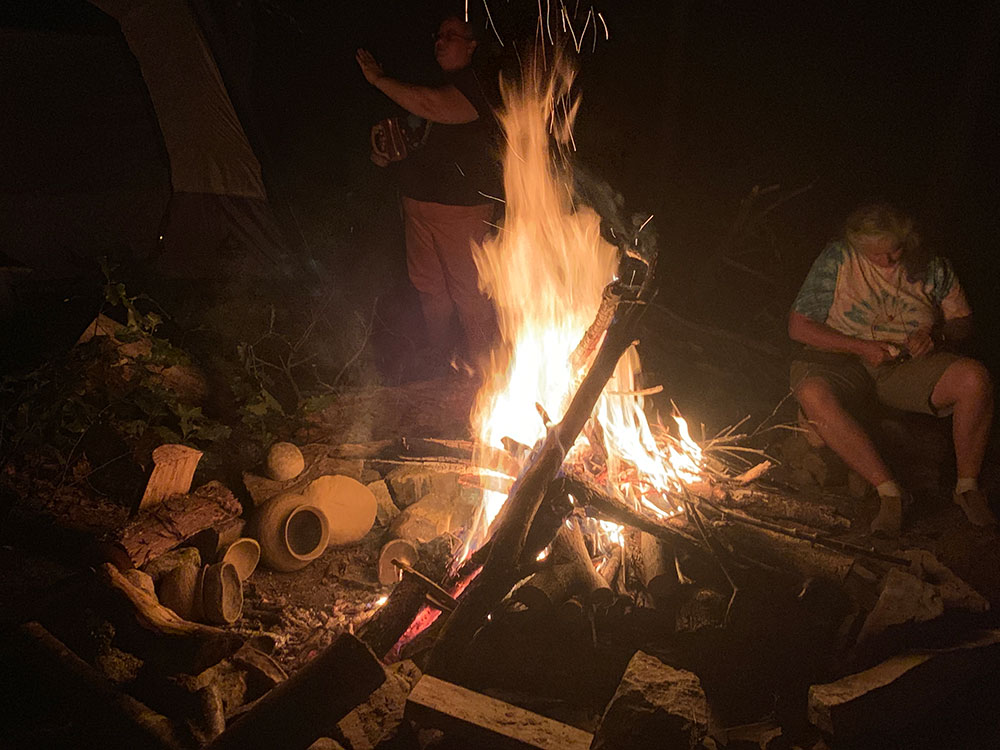
First, this community is really, really welcoming. I can’t stress that enough. I live in a rural and very conservative area, and that often translates that there are things women do and things men do, and men don’t always want to teach women “men’s” skills. Woodworking and tree work, in particular, have been really hard for me to get any decent lessons in. Here at Mountaincraft, Jason and Sera, who run the North American Bushcraft School, are diligent about their land being an accessible and welcoming place. I felt completely respected and believed in, at all times, during the gathering. I had strong women and respectful men leading awesome classes. But its not just gender diversity that is respected: all people are. The elders are respected in this community and given places of honor. The children are likewise respected, and many of them are teachers themselves. I have never been in such an open and welcoming community that honors the diversity of age, race, gender, and path so much.
Second, this community has a lot to offer people who put in the time. Besides the incredible list of skills I mentioned, there is a lot of personal work you get to do in building skills. Its a meaningful and powerful method of personal empowerment, where each new skill you learn allows you to gain confidence, gain power, and gain wisdom. One of my druid friends, also a woman, spent the weekend learning blacksmithing, making weapons, and throwing them. Her body was sore but her heart was full. She took the warrior’s path, much different than my own bardic journey, and yet, both were fulfilling and enriching for us. Starting my fire with the bow drill changed something within me; it connected me deeply with my ancestors but also seemed to unlock some as of yet unknown potential within me. All I can say is that I left that gathering a different person than I came, and what that means will likely take some time to sort out through more fire building and bow drill practice.
Third, this gathering teaches deep nature knowledge and nature awareness. Nature has so many facets to learn: identification, edible/medicinal virtues, and many other uses–each of these offers a different “face” of a plant. There is such a difference between being able to ID a tree and learning how to make something from its fallen trunk, knowing just the right wood and part of the wood to choose. Before this gathering, basswood was simply a nice tree that I could identify and whose flowers made a demulcent tea. By learning how to make a bow drill of basswood, I learned much more about the qualities of this tree–how the wood behaves, how soft it is, how it smells when it burns, how it carves. Thus, I learned a bit of the tree’s magic: what wisdom and resources that it can offer. Nature knowledge comes in many forms, and the path of earth skills is abundant in such knowledge.
Finally, I think earth skills gatherings offers a wonderful “earth path” supplement to my many readers who are practicing some kind of earth-based spirituality (such as AODA druidry, which we literally call “earth path” skills). These are the practical skills, folks. These are the skills that help you stay rooted and present and build nature knowledge. It is an incredible opportunity.
If you want to find a gathering near you, visit the Earth Skills Gatherings website.



Reblogged this on Paths I Walk.
Reblogged this on ravenhawks' magazine.
Reblogged this on Blue Dragon Journal.